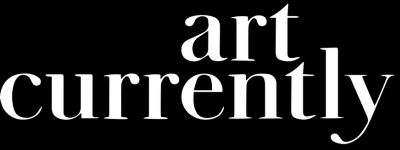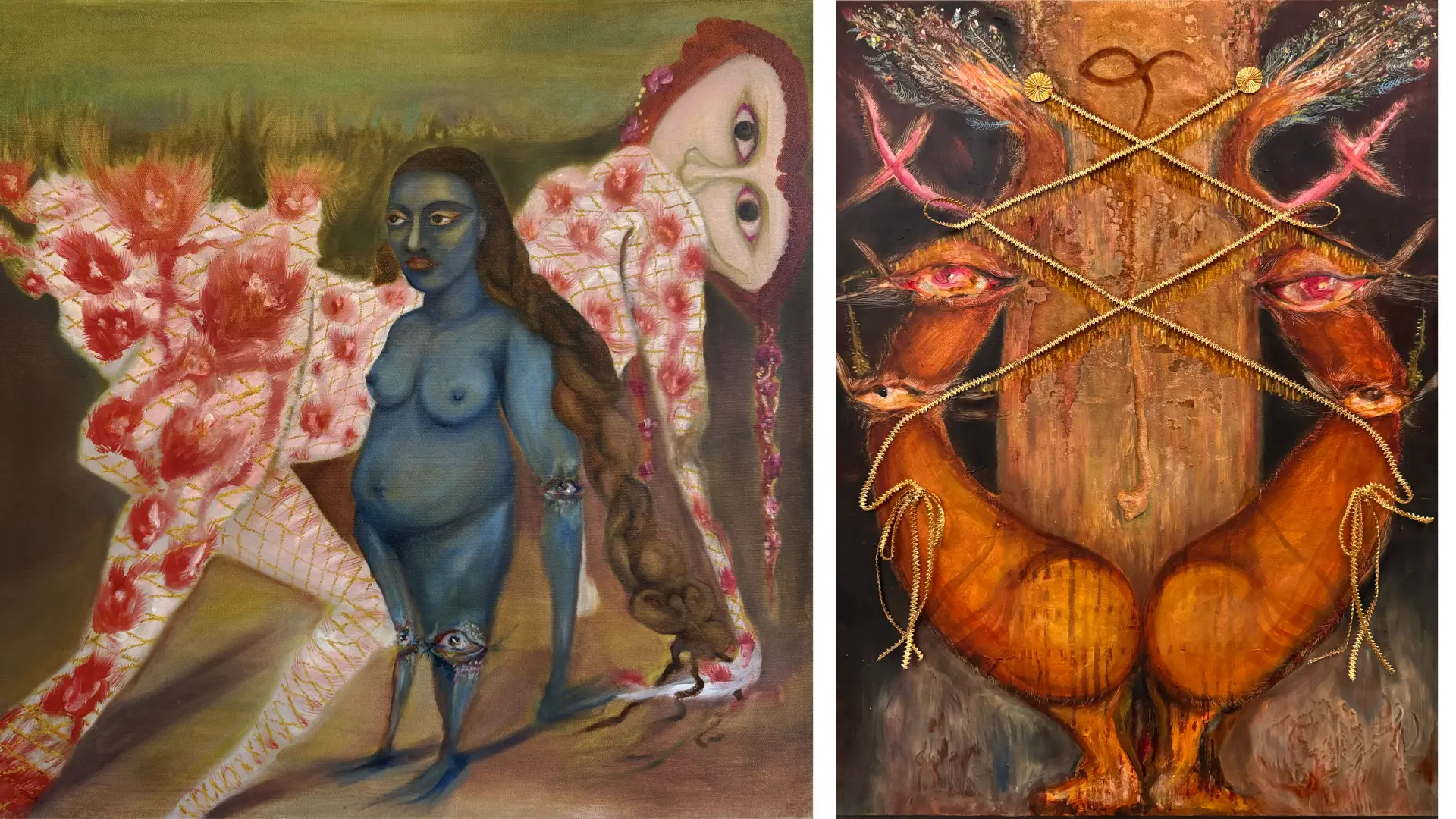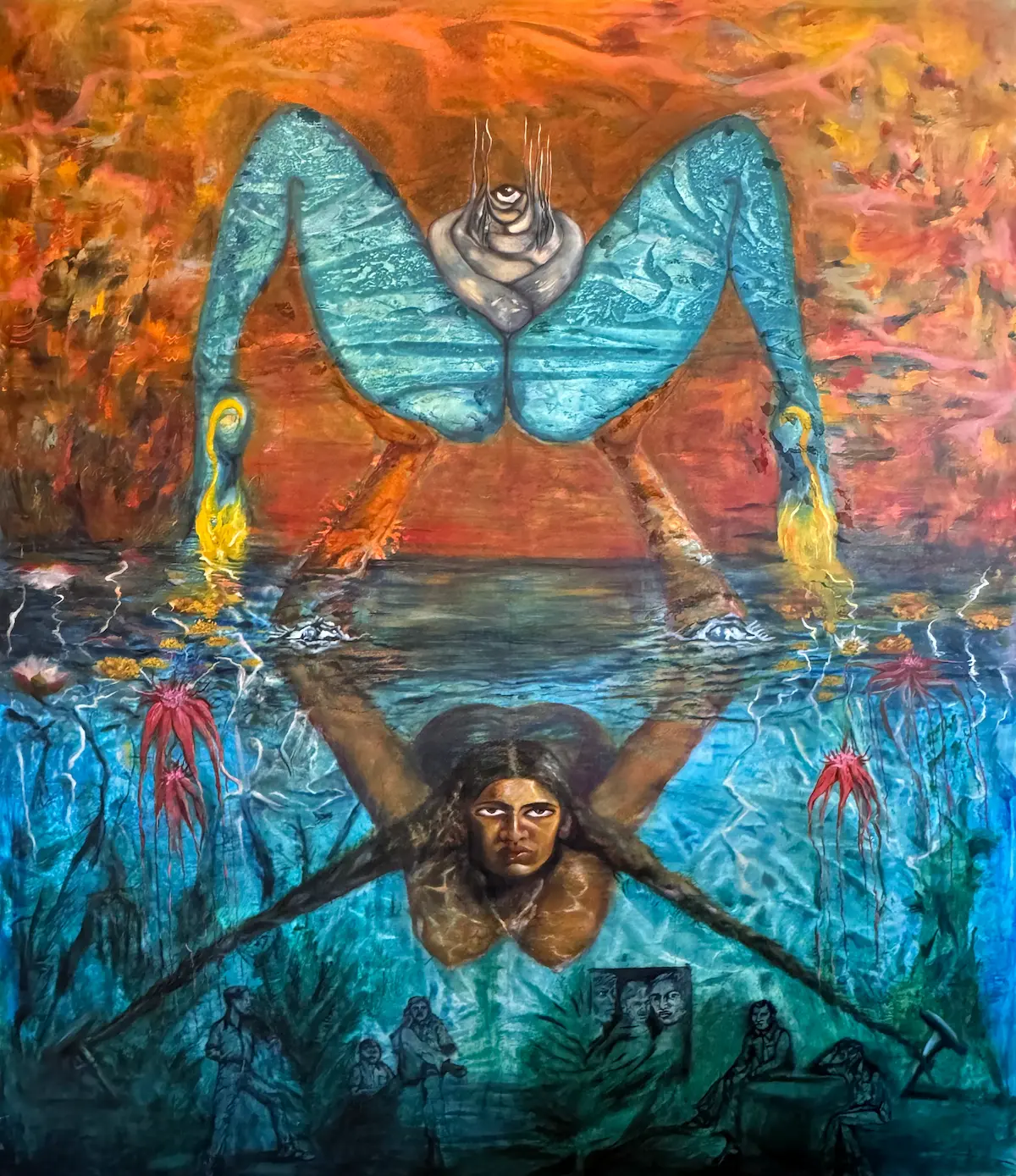Art Militant: An Interview w. Annu Yadav on Modern Esotericism
Annu Yadav, The Encounter / Bridled, Courtesy of the artist
At first glance, one might perceive the work of painter and designer Annu Yadav as if you’re in a ‘fever dream’ but it's quite the contrary. Her vivid elaborate, large scale paintings that often include beings wedged between alternate realities are interpretations of divinity, sacrifice and the existence, relationship and the earthly realities of energetic polarities. Seeing her work reminds me of a popular quote from the late artist Frida Khalo that reads “they thought I was a Surrealist, but I wasn't. I never painted dreams. I painted my own reality”.
Yadav’s work connects Indian vernacular to modern esotericism, exploring sexual suppression and the emotional nuances of the gaze. Born in Neem ka Thana, a remote village in Rajasthan 7,000 miles from her current home in New York City, her newfound freedom in the arts pushes her to create social commentary informed by morals learned throughout her Indian childhood and truths realized through American adulthood as she quotes, “I examine the cultural layers of Indian society, and defy binaries of East/West and traditional gender norms.”
In a world where a small percentage of the population controls the narrative, and society’s direction is shaped by a select few families, corporations, and governing bodies, she remains hopeful for a better way. Contemporary artists of our time like Yadav often seek refuge in intellect and rebel with confidence against the cyclical patterns in history altogether exposing the true fabrics of influence with creative resistance toward the ‘system’ and its functioning arms in hopes of creating new perspectives for generations to come.
Last year was a busy year for Annu, exhibiting solo shows at SVA, NYAA, Quiet Lunch (NYC), Casa Lu (Mexico City), and Throckmorton Arts (California). Her recent brand partnerships include French label, Orveda, where she exhibited a series entitled “Folds of Dreams” in their Madison strorefont amongst some of the most powerful players in art, fashion and media — even drawing guests as prominent as Vera Wang. She has participated in group exhibitions at IIDR and Agora Gallery (NYC) and completed residencies last year at NYAA and SVA. She currently holds two degrees, a BA in Fashion and Textile Design from NIFT, Ahmedabad (2007) and a Masters from California College of the Arts (2013).
This Thursday, All Street Gallery opens a solo show curated by Bebe Uddin, Gold God Meat, featuring a series of Annu’s paintings, sculptural installations, and sketches that animate the precarious tension between reality and artifice. Yadav goes on record to say this exhibition serves as a reflection of her inner world. She feels the exhibition and the language of the series leaves her at peace with where life has taken her. The artist elaborates on the relief she has felt from the pressures of her upbringing, to her journey through the Americas, now residing and getting accustomed to New York City.
“God Gold Meat” as an energy represents many deaths in her life — not only the death of a past life and identity she worked so hard to build in her previous home in California, but also her 15 year career in design. Annu also reflects on this exhibition being a transformative experience for her, as she heals from a past relationship while starting something new in a foreign environment in the world’s art capitol, a place that offers newcomers a full immersive experience of uncertainty surrounding life, stability, finance and love.
Annu Yadav, The Groom, 2024. Oil on Canvas, 36 x 36 inches
“This exhibition is the most spiritual that I’ve gone”, the Indian born multidisciplinary artist responds when asked about her feelings while creating this powerful series of works. She adds, “It brought a sensational amount of growth in me in my sexuality and in my anchoring in the world. I’ve experienced a lot of loss in this process, also. Over the past year of my life, my grandma, my aunt and a dear friend passed away. This was the first time I had to go through so much loss in such a close proximity. All of these emotions led me to begin thinking about what life means in the sense of mortality which led me to studying a lot of death rituals in Hindu culture. This period of my life allowed me so much freedom in exploration, learning about the many stages of our ascension and transition to other lives along with the ritualistic techniques practiced in the religion – all of these things became some of the inspiration for the materiality and symbolism steeped into this work. Life changes, loss of people, time and being at peace with myself.”
The painter elaborates on being isolated for a lot of the time before and during the creation of these works.Yadav used her free moments for meditation, spending hours and hours with herself, planting the seed of womanhood in the middle of it all. Her attempts at grounding in her role of womanhood and divinity led her to studying many philosophies, occult practices and different movements in art history all leading her to a definitive path in her conversation as an artist. The imagery in her work points to very serious contexts in her personal life and challenges she faced as a designer and artist over the past two decades.
Annu gives life to these emotions in one of her more vulnerable works titled, “In her Self-Replicating Organism”, on view at All Street Gallery, as a fevered vision unfolds between fire and water, ascent and descent, myth and brutal reality. A woman’s inverted, duplicated body dominates the canvas—her monumental legs arching skyward yet dissolving into flame. Beneath, a woman surges through water, her gaze both accusatory and seductive, yet the water is thick with specters—bodies in waiting, lineage she neither escapes nor fulfills. She is not a victim. She does not submit—she seizes. The body above is bound in ritual; the body below resists, propelling itself forward, embracing suffering as transformation. Violence, cruelty, and humiliation do not consume her—she wields them as tools of reclamation. Water does not drown her; it churns, birthing something new. Like Samudra Manthan, her existence reveals both amrit—the nectar of life—and the buried poisons of the past.
Along with a score of canvases, the exhibition includes installations by Annu – one that really stuck out to me. Titled for obvious reasons, “Shraad” – a spectral tapestry of kapda (cloth) cascades over a male figure, forming a shrine-like structure that blurs the line between interiority and exteriority. The layered fabric suggests both protection and entrapment, echoing the cycle of trauma. The victim remains beholden to the specter of the perpetrator, carrying his presence like a clinging shadow.
“The death aspect was fresh in my mind”, Yadav comments., I immediately understand the undertone of anger and frustration that one experiences in her work as she carefully expounds on the many women of her culture, and many worldwide, who transition after living a life of servitude from father to husband. The exhibition also includes some of this story, in a brief moment of allegory, with a beautiful poem immortalizing femininity returning the woman to the forefront of thought. She wanted to create a monument in memory of those who have gone before her, reclaiming the respect that they weren’t given even after they passed away.
During our interview, Annu was in her studio working on the final touches of the exhibition, actually finishing the commemorating canvas to the poem. She explains, “I’m literally making a temple for whoever ‘her’ could be. The women who do thankless work, bringing the connective analogy of having respect for the woman is having respect for the divine entity. We are not just the vessels, we are the instruments through which the divine act of creation is emulated. What do we worship about God? Why do we worship God? Things we cannot answer for ourselves and a lot of things that women’s bodies are capable of we still have not been able to decipher. Through this work, I really want to nail down and bring the idea of femininity closer to nature because it's often misunderstood. ‘She’ is taking over and in divine nature.”
There’s also trauma that comes from my past being from India where every religion has an abundance of sexual abuse and gender based violence and I just started to not enjoy this idea of religion early on. I’ve come to it more later in my life even with the fact that I grew up with all of these goddesses. In a country where we worship so many goddesses, there is so much violence against women so I always called things out as ‘facade’ and ‘bullshit language’. I began to acknowledge religion, allowing myself space for learning by studying it on my own and then I began to understand more — eventually finding myself at the highest level of spirituality that I’ve been previously. I still like to see myself as a very pragmatic human when it comes to science but when you lose someone, it brings a lot of ideas of comfort in the practices of Hinduism and reincarnation, which became more comforting for me rather than the binary aspects of heaven and hell in the more prevalent Western cultures.”
Annu Yadav, Self Replicating Organism, 2025, Oil on canvas, 72 x 60 inches
While Annu’s work usually focuses on the conversation around femininity, womanhood and the divinity that exists within the two, she often shows empathy to the relationship between man and woman. The exhibition offers a moment of marriage in her works, “The Groom” and “The Encounter”. “The Groom”, a display of honor and pity framing a sense of matrimony in this danse macabre. A portrait of a garlanded groom, enshrined in an ornate frame, does not rest on solid ground but is mounted atop a monstrous steed, quivering under the weight of inheritance. Flesh writhes, adorned with unblinking eyes, as if society’s gaze is etched into his being. Masculinity here is not exalted but burdened, a marionette of lineage and duty, ensnared by the sanctity of marriage.Womanhood confronts its legacy of rot and resurrection in the “The Encounter” where a pregnant, blue-pigmented figure stands heavy with fertility and transformation. A lace-clad, fragmented specter contorts beside her—its flesh both bridal adornment and ruin. Her body is not her own. Her braids root her to the earth, her legs inscribed also with unblinking eyes, forever surveilled, bound to the performance of devotion.
When asked about the relationship between the two works, Annu explains, “Again, it's my take on this idea at play. An idea in romanticism of our lives, of youth and of optimism. This idea of romantic lighting, green lush and landscape but also this more sentinel creature who can be a friend or benefactor. He also could be an understanding of herself, or avatar, all creating a compiled composition of togetherness and sense of kinship with ourselves.”
“The Bridled” which was the show’s original form of communication of this said bond is a twist out of a previous urge to display the sacred interaction between the two. The figure represents a woman illustrated in her divine feminine yet shackled in gota, a gold trim from her travels home to Rajasthan, India. The artist does a wonderful job of engaging in the physical relationship between the masculine and the feminine as entities where viewers are given a dual entry point and order of time when encountering her dialogue of the two, where the trinity (“The Groom”, “The Encounter” and “Bridled”) could ultimately be digested as disposition or rebuttal. Showing emphasis to the physical relationship in human form rather than divine exemplifies the differences we experience here on earth while also understanding the contrast, the masculinity and femininity eternally converge, intertwine and feed off of each other. “The union is what's divine.”
Annu is able to help you challenge your own views, erasing the usual absolute thoughts and interpretations on the divine. Her works offer self reflection and an eradication of time, encouraging a recalibration on how we view empathy, emotion and passion towards one another. When asked if this exhibition was ‘just a New York exhibition’ or if it could be replicated anywhere else, including India, Yadav replied with no hesitation, “I really believe the container in which you make the work informs the work tremendously. My presence in New York has affected my life and my life indirectly depicted in these works. I’ve never made autobiographical works and never painted a self portrait yet this is all an internal feeling.
I went to India with a friend last year and as I was there, I considered my placement in the West which helped shape an already concrete idea of not wanting to be another Indian artist — I want to exist as an artist. I’m intentionally breaking boundaries between East and West..”
We discussed her familiarizing her parents with her body of work when they visited New York in 2024 and how finally receiving her conversation in the physical was a milestone for the experienced artist. Being a woman artist in, or even from, India is a very peculiar lifestyle. She remembers her early upbringing, noticing how women weren’t much considered, witnessing her mother not being able to pursue higher education, “It’s a different world. My mother was allowed to study until the 8th grade and was married at 17. So, she wasn’t allowed much of the opportunity I’ve been able to experience. It is because of her courage that I am sitting here talking to you. In design school, I began to create fashion pieces as verbal sculptures that helped me express my emotions without saying the words but I didn’t like the idea of just making things look pretty and sellable as fashion suggests. My language in fashion produced a lot of objects that weren’t much functional or comfortable to wear being that most of the garments used endless yards of heat treated fabric which led me back to a more physical art form.
This all led me to traveling to San Francisco where I began a career in design strategy after attending the California College of Arts, which involved a completely different palette of thought versus previous studies in fashion. After graduation, I got on the legal immigration train to get my green card and after this, I fully immersed myself into the arts.”
Annu felt “stuck” throughout her journey to citizenship. Unfortunately, she was unable to pursue arts as strongly as she desired because as an immigrant one must keep a job so Yadav quickly joined the corporate field as a Head of Design at a tech firm. The young creative began to run the brand team, design team, content strategy but it didn’t allow her a lot of time. During this period, she continued to show art and exhibit her creations but once receiving her green card, there was no looking back.
Today, Yadav is focused on occupying space in the Manhattan art scene and looks to continue inspiring women worldwide one idea at a time. In July 2025, she will present a solo exhibition at Koik Contemporary in Mexico City.





